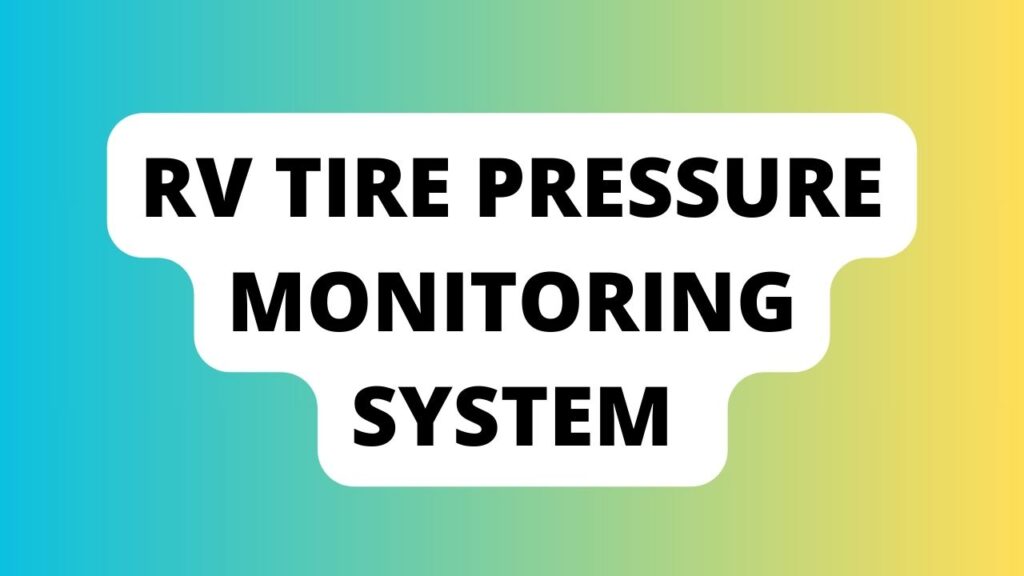Introduction
Ensuring optimal tire pressure in recreational vehicles (RVs) is crucial for safe and efficient travels. The RV tire pressure monitoring system has emerged as a critical tool for RV enthusiasts, offering real-time monitoring and alerts, enhancing safety, and preventing potential mishaps. Let’s dive into the comprehensive guide to understanding, installing, and maximizing the benefits of an RV tire pressure monitoring system.
Understanding Tire Pressure and its Significance
Maintaining appropriate tire pressure is pivotal for several reasons. Exploring Tire Pressure Basics: Understanding PSI (Pounds per Square Inch) and its role in tire health.
Importance of RV-Specific Monitoring Systems
RVs have unique tire needs, demanding specialized monitoring systems. RV Tire Pressure Monitoring Systems Explained: Tailored functionalities catering to the demands of RV travels.
Choosing the Right Monitoring System
Selecting the ideal monitoring system is a critical decision for RV owners. Factors to Consider When Choosing: LSI Keywords: Durability, accuracy, ease of installation, and compatibility with RV models.
Installation Guide for RV Tire Pressure Monitoring Systems
Installing the system correctly ensures its efficacy and reliability. Step-by-Step Installation Process: Simplified instructions for hassle-free setup.
Optimizing System Performance
Maximizing the benefits of the monitoring system ensures a safer journey. Tips for System Optimization: Regular checks, battery maintenance, and understanding alert signals.
Real-Life Benefits of Using RV Tire Pressure Monitoring Systems
Personal experiences highlight the system’s impact on RV journeys. Enhanced Safety and Peace of Mind: Testimonials from seasoned RV travelers.
Common Misconceptions about Tire Pressure Monitoring
Clarifying myths and misunderstandings surrounding tire pressure monitoring. Debunking Misconceptions: Addressing common myths about RV tire pressure.
Importance of RV Tire Pressure Monitoring System
Maintaining optimal tire pressure significantly affects fuel efficiency, tire lifespan, and overall safety during RV travels. The RV TPMS ensures timely detection of under-inflated or over-inflated tires, averting potential blowouts and accidents. With accurate pressure monitoring, it offers peace of mind, enabling travelers to focus on their journey without worrying about tire-related mishaps.

How Does RV Tire Pressure Monitoring System Work?
The RV TPMS operates through sensors placed on each tire, continuously monitoring pressure and temperature. These sensors transmit data to a central display unit in the RV, providing real-time updates on tire conditions. Upon detecting anomalies, it alerts the driver, enabling prompt action to rectify any potential issues before they escalate.
Benefits of Installing RV TPMS
- Enhanced Safety: Real-time monitoring minimizes the risk of tire-related accidents.
- Improved Fuel Efficiency: Maintaining optimal tire pressure positively impacts fuel consumption.
- Extended Tire Lifespan: Properly inflated tires experience less wear and tear, elongating their lifespan.
Installation of RV TPMS
Installing an RV TPMS involves straightforward steps:
- Sensor Placement: Mount sensors on each tire’s valve stem.
- Central Display Unit Setup: Install the central unit within the RV’s dashboard or a visible location.
- Sensor Pairing: Sync sensors with the display unit for seamless communication.
RV Tire Pressure Monitoring System Maintenance
Regular maintenance ensures the RV TPMS functions optimally:
FAQs
Can an RV tire pressure monitoring system be retrofitted to any RV model?
Yes, most systems are adaptable to various RV models, offering versatility in installations.
How often should I check my RV tire pressure?
Regular checks are advised, ideally before every trip and monthly during storage periods.
What are the consequences of incorrect tire pressure in an RV?
Incorrect pressure can lead to reduced fuel efficiency, tire wear, and potential safety hazards.
Are these monitoring systems easy to calibrate?
Yes, most systems come with user-friendly calibration processes for ease of use.
How long do the batteries in these monitoring systems last?
On average, the batteries last between 1 to 2 years, depending on usage.
Can extreme weather conditions affect the accuracy of these monitoring systems?
Extreme temperatures might slightly impact readings, but modern systems are designed to minimize such effects.
Conclusion
The RV tire pressure monitoring system stands as a beacon of safety and efficiency for RV enthusiasts. Embracing this technology ensures safer journeys, prevents mishaps, and fosters a smoother travel experience.
